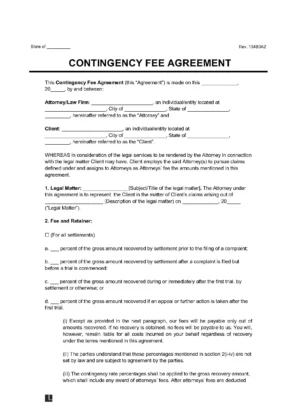
Use a Contingency Fee Agreement to outline the terms and conditions of obtaining services from an attorney with a contingency fee.

Updated May 27, 2024
Written by Ioana Gagiuc | Reviewed by Brooke Davis
A contingency fee agreement is a legal contract between a client and a lawyer. In this agreement, the lawyer only gets paid if the case is won, providing clients access to legal services they may not otherwise afford. Lawyers’ fees are a percentage of the money they recover, typically ranging from 25% to 40%.
A contingency fee is a method of obtaining services from an attorney based on the outcome of the case. Unlike other attorney fees for each hour of service provided, a contingency fee is paid only when your case is resolved successfully.
Here are the key points:
Contingency fees are frequently used in cases where the potential financial recovery is uncertain, such as:
Contingency fees are commonly used in personal injury cases. After a car accident, for example, an attorney agrees to take on the case, providing the victim with legal support to seek financial compensation for their losses.
With a contingency fee agreement, the attorney is only paid for their services if the victim receives a settlement or payment from the other party.
If they lose the case and the victim does not receive payment, the attorney does not receive full compensation.
A contingency fee agreement template can help create a comprehensive, well-organized document. It should typically include the following:
Complete the clarification points at the top of the form, including the names and addresses of those involved. Include the date.
Include a description of the legal matter for which the attorney will provide services and the date that will occur.
In the fee and retainer service, read through the options and select the best one for when the contingency fee and retainer will apply and the specific percentage of recovered funds owed to the lawyer. Next, list the retainer fee agreed to.
Agree to the settlement amount for any of that work or other work hourly.
Costs of pre-litigation negotiations and hourly services if the case doesn’t proceed.
Discuss and cover all pre- and post-litigation responsibilities.
Fill in the hourly rate related to the demand notice and then for any out-of-pocket costs for which the client will be responsible.
In the termination section, outline the circumstances if the agreement ends for work already completed or either party can withdraw.
Agree that the client received all the information from the lawyer.
Define the resolution methods to be used in case of any dispute, such as court litigation, binding arbitration, or mediation.
Confirmation of the document as a binding agreement.
Limitations on legal services provided and no guarantees regarding the case’s outcome.
Signatures are then placed at the bottom and should be notarized.